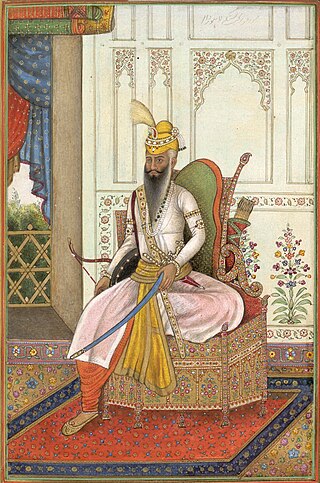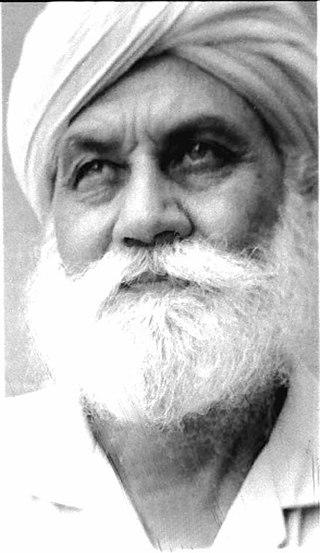
Ranjit Singh, popularly known as Sher-e-Punjab or "Lion of Punjab", was the first Maharaja of the Sikh Empire, which ruled the northwest Indian subcontinent in the early half of the 19th century. He survived smallpox in infancy but lost sight in his left eye. He fought his first battle alongside his father at age 10. After his father died around Ranjit's early teenage years, Ranjit subsequently fought several wars to expel the Afghans throughout his teenage years. At the age of 21, he was proclaimed the "Maharaja of Punjab". His empire grew in the Punjab region under his leadership through 1839.

The Punjabis are an Indo-Aryan ethnolinguistic group associated with the Punjab region of South Asia, comprising areas of present-day eastern Pakistan and northwestern India. They share a common history, culture and language, generally speaking Standard Punjabi or various Punjabi dialects on both sides.

The Shiromani Gurdwara Parbandhak Committee is an organization in India responsible for the management of Gurdwaras, Sikh places of worship in states of Punjab and Himachal Pradesh and the union territory of Chandigarh. SGPC also administers Darbar Sahib in Amritsar.

Majha is a region located in the central parts of the historical Punjab region split between India and Pakistan. It extends north from the right banks of the river Beas, and reaches as far north as the river Jhelum. People of the Majha region are given the demonym "Mājhī" or "Majhail". Most inhabitants of the region speak the Majhi dialect, which is the basis of the standard register of the Punjabi language. The most populous city in the area is Lahore on the Pakistani side, and Amritsar on the Indian side of the border.

Khalsa College is a historic educational institution in the northern Indian city of Amritsar in the state of Punjab, India. Founded in 1892, the sprawling 300-acre (1.2 km2) campus is located about eight kilometers from the city-center on the Amritsar-Lahore highway, adjoining Guru Nanak Dev University campus, to which Khalsa College is academically affiliated.

Kartar Singh Sarabha was an Indian revolutionary. He was 15-years old when he became a member of the Ghadar Party; he then became a leading luminary member and started fighting for the independence movement. He was one of the most active members of the movement. In November 1915 at Central Jail, Lahore, he was executed for his role in the movement. He was 19 years old.
Malwa is a geographical region in the south of Punjab state in India. It is located between south of the Sutlej river, north of the Ghaggar river, east of Pakistan, and west of the Sivalik Hills.
Jat Sikh or Jatt Sikh is an ethnoreligious group, a subgroup of the Jat people whose traditional religion is Sikhism, originating from the Indian subcontinent. They are one of the dominant communities in the Punjab, India owing to their large land holdings. They form an estimated 20–25% of the population of the Indian state of Punjab. They form at least half of the Sikh population in Punjab, with some sources estimating them to be about 60–66% appx. two-third of the Sikh population.

The Battle of Nadaun, alternatively known as the Hussaini Yudh, was fought at Nadaun, between Raja Bhim Chand of Bilaspur (Kahlur) and the Mughals under Alif Khan. Bhim Chand was supported by Guru Gobind Singh and the Mughals were supported by other hill chieftains, notably Kirpal Chand from Kangra and Dayal Chand from Bijharwal. Bhim Chand and some hill chieftains, after conclusion of Battle of Bhangani had refused to pay tribute to the Mughal emperor which led to the battle at Nadaun. The battle resulted in the victory of Bilaspur State and Sikh alliance.

Sardar Gujjar Singh Bhangi was a Sikh warrior of the Bhangi Misl, and one of the triumvirates who ruled over Lahore prior to the leadership of Maharaja Ranjit Singh.

Teja Singh was an Indian Sikh scholar, teacher, author and translator.
Sobha Singh Kanhaiya of Niazbeg, his first name is alternatively spelt as Suba or Soba, was one of the triumvirates who ruled over Lahore, alongside sardars Lehna Singh Kahlon and Gujjar Singh of the Bhangi Misl, prior to the leadership of Maharaja Ranjit Singh.

Teja Singh Sutantar, also Swatantar, was a national revolutionary of India who fought for the independence of India from the British Empire and for the liberation of Punjab peasantry from the clutches of feudal lords. He was a member of the 5th Lok Sabha from Sangrur constituency as a CPI candidate. He also was Member of Punjab Legislative Assembly from 1937 to 1945 and member of Punjab Legislative Council from 1964 to 1969.

Sardar Kapur Singh (1909–1986) was an Indian civil servant in Punjab and later a politician belonging to Shiromani Akali Dal. He was a Sikh intellectual, and wrote about Sikh religion and politics. He was also the author of the Anandpur Sahib Resolution of the Akali Dal in 1973, demanding rights of Punjab and the Sikh community. Singh was proficient in multiple languages including English, Punjabi, Persian, Arabic and Sanskrit.

Nirmala also known as Nirmala Saṁpardā or Nirmal Paṅth, is a Sikh sect of ascetics. According to the traditional beliefs, the Sanatan Nirmala Sikh tradition was founded by Guru Gobind Singh in late 17th century when he sent five Sikhs to Varanasi to learn Sanskrit and Vedanta texts.
Vadbhag Singh Sodhi was a direct descendant of Guru Hargobind and a prominent figure of the heretical Dhirmalia sect of Sikhism.
Giani Sher Singh, born in January 1890 in Thikriwala, in Punjab, India was a political leader and newspaper editor. As a result of his extensive knowledge for Sikhism, he came to be known as Giani.
Maan or Mann is an Indian surname used by the Jat people in the states of Punjab and Haryana. Mann(Sikh Chiefs) who once ruled the Principality’s state of Mughalchak have a strategic marriage alliance with Aristocratic Family of Sukerchakia

Brahmin Sikh is a Sikh religious group whose members belong to Brahmin community. They played a key role in the early years of Sikhism. Sometimes called Kashmiri Sikhs those who are of Kashmiri origin.














